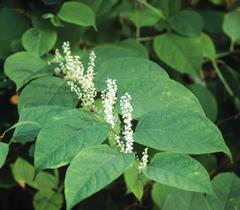Despite the fact that many scientists have resorted to chemicals and non-biological means of controlling invasive species, none have truly worked especially when using it against those plant species such as the Japanese Knotweed that have become so established here in the United States. One method that can be used which few scientists have explored is Allelopathy.

Simply speaking, allelopathy is when plants produce compounds that can inhibit growth of other plants. This is a problem in places where invasive species can destroy many native plants by producing bio-molecules that are able to supress and ultimately kill nearby plants. However one can picture a reverse scenario whereby it is possible to use native plants that has allelopathic properties and suppress the growth of invasive species. Such a task may prove daunting due to the fact that in a given area, estimating and investigating which particular plant has specific allelopathic properties for a given invasive species, may prove time consuming and expensive.
One way to avoid this is by the use of molecular genetics. Molecular biology has both solved many mysteries in the botanical world and also heightened confusions even more with respects to certain subjects be it the better understanding of plant genetics or the continuing debate of the phylogenetic classification of living organisms. A good proposal would be to use the science of genetics and "engineer" a plant so that it possess that allelopathic property necessary to eradicate an invasive species in the given area. Not only can this method prove more effective but also more sustainable which is the new keyword of ecology today. Rather than spend thousands to millions of dollars in investing in state of the art chemicals and losing many native plants due to herbicides specifically meant for the invasive species, one can eradicate invasive species by using native plants and harnessing an allelopathic property that can both eradicate invasive species but also keep it from becoming established and also propogate itself (in the case of the dominant tree in the area).







Comments